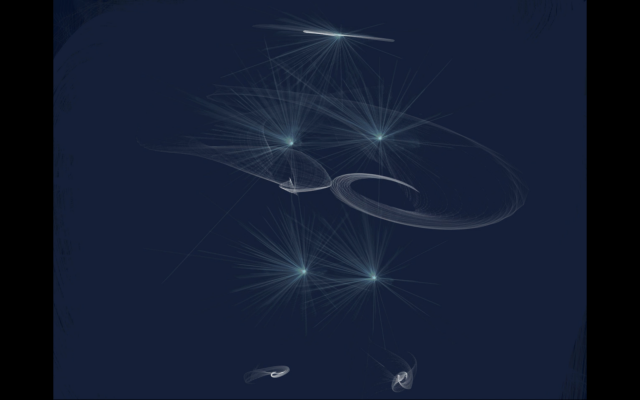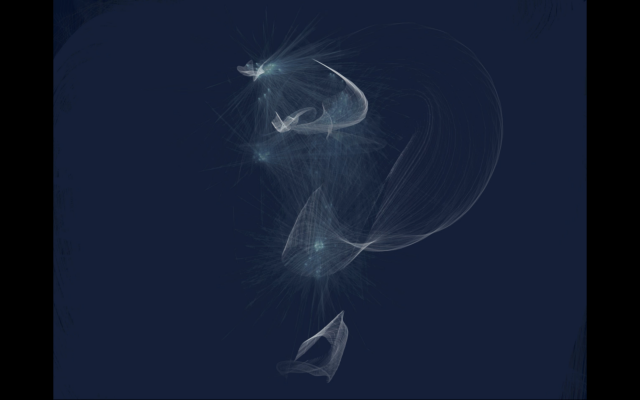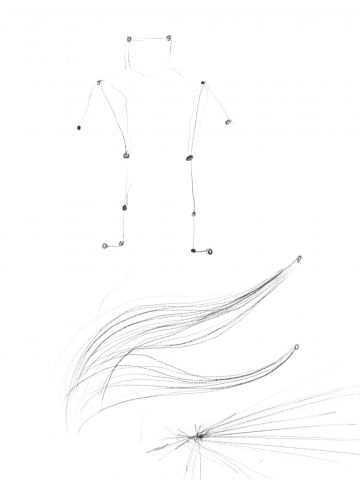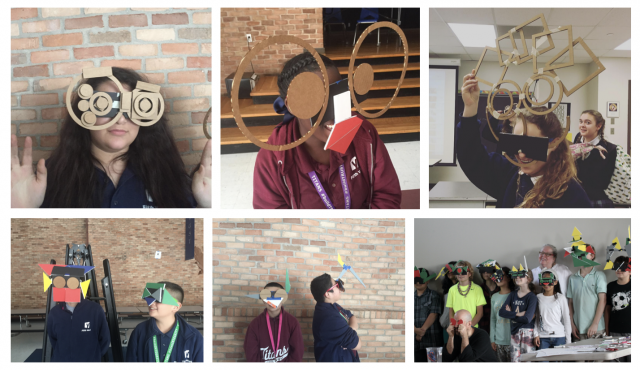The reading Against Black Inclusion in Facial Recognition was very interesting to me because it is the first time I have encountered an opinion which is against the inclusion of nonwhite faces in facial recognition software. After reading, it only makes sense to have this opinion – if the tool is made by and for the oppressor, then it makes sense to not want to be included in the software’s scope. This stuck out to me because it is easy to get caught up in the hype of modern technology and to want to have a part in it, but this reading has brought up the very important point which is to be aware of the possibility that the effects of this modern technology can be very harmful.
Category: 06
spingbing-AugmentedBody
My artwork is a piece of software which gradually covers the face in jittery dots which are meant to act as a method to blur the face into obstruction. I used HandsFree.js to achieve this code.
Unfortunately, I did not have the time or means to do my performance. I am planning on borrowing lights from the 3rd floor lending office and using an empty room to record this piece. My plan is for the video to start at complete darkness and slowly increase the light on my face at an angle at the same rate in which my face is obstructed, creating a sort of dynamic contrast between the “uncovering” of my face with the light vs the anonymization of the filter. The video would be less than 30 seconds long.
When finished, I think this piece will be fairly strong due to its conceptual implications. My interpretation is that it has to due with performative activism or representation done by the broader media.
Koke_Cacao-AugmentedBody
Play it here: https://kokecacao.me/page/Course/S22/60-212/code/p5/dino/index.html

(Note: No sketches were created in the process of making this project)
Solar-AugmentedBody




I wanted to play with weightless, fluid visuals that respond to one’s movement, something that can enhance the lightness of a dancer’s movement. Hence, I played with visualizing particles that follow specific points of the body: hands, feet, knees, elbows, and the head. I am happy with the vague silhouette that is visible when one walks around and also the abstract fluid forms that result from the swinging of an arm or kick of a leg.
kong-facereadings
In Last Week Tonight’s Face Recognition video, it mentioned how facial recognition no longer applies only to humans. As an example, it demonstrates how sensors can scan fish and apply image processing to identify the fish as well as any relevant symptoms. This struck me as I wasn’t aware or ever thought about this idea. I believe that this opens a myriad of opportunities not only for creative practices but also for real-life problem solving, such as protecting endangered animals. Personally, as a pet owner, it would be helpful to have a pet recognition technology: it would detect and share the pet’s location with the pet owner to minimize pet loss.
The idea of algorithm bias itself was very striking to me as I’ve haven’t deeply thought about the negative sides of face technology before. More specifically, in Against Black Inclusion in Facial Recognition by Nabil Hassein, it mentioned facial recognition’s racial bias and law enforcement use. Though it can be used for good, it raised a point that it could strengthen police control and thereby deepen on-going racial bias. This made me wonder if facial recognition technology is “really” good and if there are ways to ensure that it is solely used for its benefits.
starry – facereadings
Kyle McDonald – Appropriating New Technologies
“What we discovered is that that expression alone is sufficient to create marked changes in the autonomic nervous system” (Paul Ekman)
I thought this was interesting because it seems like human emotion is usually dictated by some internal mechanism within the brain and being able to induce emotion purely based on physical motions was not something I’d considered before.
Nabil Hassein – Against Black Inclusion in Facial Recognition
“Machine learning researchers have even reinvented the racist pseudoscience of physiognomy, in a study claiming to identify criminals with approximately 90% accuracy based on their faces alone — using data provided by police.”
I thought the arguments the author discussed were very interesting, the quote above reminded me about how important it is to understand the societal impact of any piece of technology especially when it can perpetuate racist ideas and not simply focus on innovation or technical mastery.
hunan-facereadings
Against Black Inclusion & How I’m Fighting Bias
The discussion around algorithmic justice (especially with facial recognition) had been at the center of attention for a while now. I’ve thought a lot about it and concluded the following:
- I don’t think we’ll be solving the problem by eliminating the technology. Technological advancements have been a constant in human history except for a few cases where mass destruction (biological, chemical, nuclear weapons) or major ethical challenges (human cloning) are concerned. Facial recognition and its application are not qualitatively different from many other biometric systems such as fingerprinting.
- Though facial recognition is more powerful, it is not qualitatively disruptive as other technologies such as cloning humans. Thus, the technology itself should not be the subject of concern — it merely reveals and amplifies the existing systemic injustice and oppression. For example, it was mentioned in one of the articles that the US is planning on using facial recognition to trach everyone who is leaving the country. However, the same tracking system (implemented with fingerprinting) has been in the U.S. for aliens and in China for all citizens. With qualitatively different and destructive technologies, it would make more sense to control the technology itself, as its destructive quality is independent of its ownership and usage. Whereas in this case, it would make more sense to direct the fight for justice towards those who are using the weapon (the state, the government, the capital, etc.) than the weapons themselves (the technology.)
- I’m by no means downplaying the potential harm of misusing technology as a tool of oppression. As someone who’s lived in China and seen how technology is fast-tracking the blatant violation of basic human rights in Xinjiang and Tibet (and many other places around the world,) I’ve witnessed the destructive power of information technology. This is not new — IBM’s punchcard and computer systems found some of their earliest uses in the Holocaust and greatly improved the efficiency of ethnic cleansing. However, compared to other technologies, information technology does provide hope for more open-sourced, democratic distribution of power. Unlike military and nuclear power, which are held exclusively by the state, we see more individuals and NGOs leveraging the power of information technology to exert influence on a previously unimaginable scale (a recent example would be the involvement of civilian hackers in the Russian invasion of Ukraine; decentralized cryptocurrency is another example.) Though alarmed by its potential harm, I also remain optimistic for the future of technology and democracy.
merlerker-facereadings
Happy Things by Kyle McDonald & Theo Watson (link)
Dug a bit into this project and I love the concept – it posts a screenshot of your computer whenever you smile (w the implicit assumption that something on your screen made you smile). Sadly most of the screenshots showcased are people testing out the app 🙁 Would want to “live” with it for a while.
Useful tip: Aligning eye position to do face averaging.
Last Week Tonight / Against Black Inclusion … / How I’m Fighting Bias …
Reflecting on why exactly we need to be wary of applying facial recognition / “coptech.”
1) As we rely on facial recognition more, the times it is wrong are disastrous. The points where an infrastructure (technologies that are so embedded/hidden in the way we do things that they’re invisible) become visible are where it breaks/fails.
2) The benefit is not worth the invasion of privacy. There’s always going to be some terrible human who has the power to abuse access to personal information and will do it (like the Russian app demo’d for creeping on women, finding excuses to arrest BLM protesters)
3) Reinforces existing privileges in our society. Lack of inclusion/recognition of black faces – proposed as a form of privacy protection by Hassein, but as long as law enforcement uses facial recognition that increases the risk of misidentification.
Agree with John Oliver then that we need laws that require a person’s permission to use facial recognition on them, or stop developing facial recognition entirely. And instead, let’s use it to make art! (I think someone notable said that it’s the best use of surveillance tech.)
duq-facereadings
“Joy Buolamwini of the Algorithmic Justice League speak on wearing a white mask to get her own highly imaginative “Aspire Mirror” project involving facial recognition to perceive her existence”. I didn’t realize that biases in AI would compound into many projects that did not introduce any bias.
“In the early 1960s, Paul Ekman set out to discover whether facial expressions for communicating emotions are universal or cultural. He travelled the world with photographs of distinct faces, even traveling to remote locations, and found that they were interpreted consistently”. It seems obvious today that facial features are based in nature as opposed to nurture, I hadn’t realized that someone most likely had to prove it before it became common knowledge.
Sneeze-facereadings

Zach Lieberman, Más Que La Cara Overview
I liked how their process went above and beyond what I was expecting. They hosted workshops with high schoolers to create cardboard masks to connect with the community as well as get some ideas. I think that this was really thoughtful and considered the local culture’s perception of masks. It was also an interesting way to collect ideas for masks.
Last Week Tonight: Face Recognition
It was interesting how the government of many large countries are investing in facial recognition technology for the reason of discovering criminals, but the idea is terrifying when thinking about if the government is corrupt because the technology is extremely powerful. Both gathering information about one individual or many similar individuals and could be abused in the wrong hands. I think that even if some countries decide to implement laws and regulations on the technology, other countries will not and the tools will still be abused.
